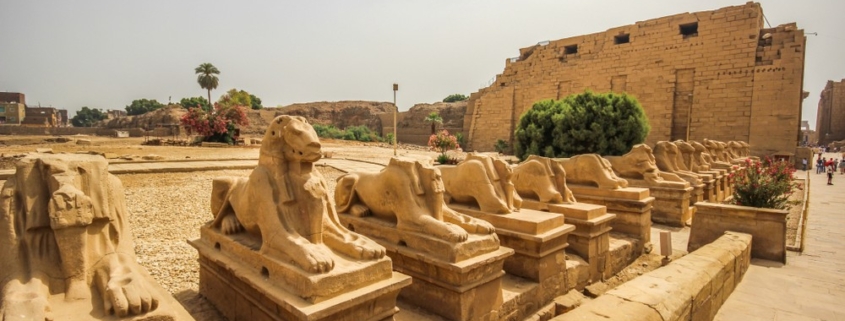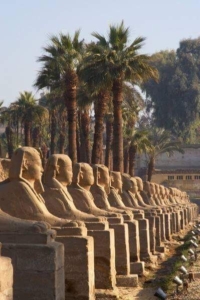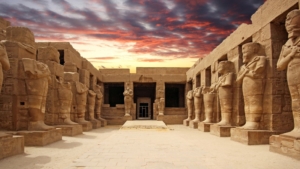Karnak temple (the largest temple on earth )
Karnak Temple
: an extensive complex in Luxor, Egypt, is a testament to the architectural endeavors of numerous builders over several generations. Erected during the reign of Pharaoh Senusret I and enhanced over more than 1,500 years, Karnak was a key locus of political power and religious life in ancient Egypt.
Unlike other singular temple structures, Karnak is a vast conglomeration of smaller structures, including towering columns, impressive obelisks, and sacred Pylons positioned along a grand processional route. With over 30 pharaohs contributing to its development, it covers around 200 acres, even encompassing a divine artificial lake.
Its most remarkable precinct is dedicated to Amun-Ra, the primary deity of the New Kingdom, with its rows of massive columns in the Hypostyle Hall proving a highlight. The precinct also includes other deities like Mut and Montu. One can trace ancient hieroglyphs etched into stone, revealing rich layers of religious dialogue and ritualistic practices.
Karnak transcends being merely a historical artifact; the temple pulses with centuries of religious ceremonies, political advancements, and cultural exchanges. It’s where priests conducted complex rites, Pharaohs showcased their divinity and military might, and commoners sought divine favor.
Enigmatic, grandiose, and weathered by time, Karnak Temple continues to reveal its secrets to archaeologists uncovering worn-down inscriptions and hidden chambers, carving a continuum between past and present explorations.
The expansive Karnak Temple Complex:
also known as Karnak, which means “fortified village” in Arabic, encompasses a collection of diminished temples, sacred buildings, pylons, and other structures near Luxor, Egypt. The construction of this complex initiated under Pharaoh Senusret I during the Middle Kingdom era and it continued to expand into the Ptolemaic period , with most of the surviving structures stemming from the New Kingdom. This historical site, anciently called Ipet-isut (“The Most Selected of Places”), served as the principal worship hub for the Eighteenth Dynasty Theban Triad, with the deity Amun positioned at its nexus. It is a part of the grand city of Thebes. Modern El-Karnak, a village situated 2.5 kilometers (1.6 miles) north of Luxor, takes its name from the temple complex and partially surrounds it.
Overview of Karnak temple :
Karnak stands as an immense archaeological spread and is home to the Karnak Open Air Museum. Renowned as one of the most frequented historical attractions in Egypt, second only to the Giza Pyramids, the site embraces four main parts, though currently, only the largest can be experienced by the public. Typically, visitors acquaint themselves with the Amun-Re precinct, misapprehending it to represent the entirety of Karnak. The rest, including the Precincts of Mut and Montu and the disassembled Temple of Amenhotep IV, remain inaccessible to visitors. Additional smaller edifices and sacred areas weave through these precincts, connecting them to the Luxor Temple. The Mut precinct, dedicated to an Earth and creation deity, stands ancient, albeit unrestored. The initial temple encountered destruction and partial reconstruction by Pharaoh Hatshepsut, with subsequent rulers altering its layout and orientation. Today, much of it may have been salvaged for use in later constructions.
What distinguishes Karnak from other Egyptian temples and locales is the substantial timeframe over which it evolved and remained active. Its diverse and vast architectural ensemble came to fruition over the course of contributions from roughly thirty pharaohs. While no singular feature is exclusive to Karnak, the sheer scale and multitude of these features are unparalleled. The spectrum of deities here spans from some of the earliest venerated to those revered later in the ancient Egyptian timeline. The remnants include an early temple initiated by Amenhotep IV (Akhenaten), notorious for establishing a near monotheistic belief system, which led him to relocate his royal court away from Thebes. The site also bears markers of subsequent adaptations, mirroring the use of ancient Egyptian infrastructure for later cultural religious practices.
Hypostyle Hall of Karnak :
Karnak’s Great Hypostyle Hall in the Amun-Re precinct is particularly renowned, encompassing an area of almost 50,000 sq ft (5,000 m2) with 134 colossal columns arranged in 16 rows. The majority of these columns rise 10 meters high, while 12 ascend to 20 meters with a diameter exceeding three meters. The top beams perched upon these columns are purported to weigh 68 tons, hypothesized to have been raised through the tremendous exertion of levers or laboriously hoisted up large ramps constructed from materials such as sand or stone. A lone unfinished pillar resides inconspicuously, showcasing the intended final touches which would have taken place post-installation to prevent damage. Replicated experiments highlight the potential means of transporting such megaliths using ancient methods.
History of Karnak temple :
The narrative of Karnak intertwines with that of Thebes itself, reflecting its evolving cultural importance. As the unified kingdom’s capitals shifted, so too did the prominence of corresponding religious sites. Before the Eleventh Dynasty, Thebes was relatively underdeveloped and its earlier temples modest. Shrines revered early Theban deities, including the Earth goddess Mut and Montu. Preliminary structures succumbed to invasions. Among the earliest relics is an Eleventh Dynasty miniature column featuring an inscription about the god Amun-Re. Amun, sometimes dubbed Amen, has long been Thebes’ protective deity, often depicted as a ram or a goose, signifying the “hidden god” or “hidden.”
If you would like one day to visit this great temple and know more about its secerts check this link here for more details and special offers
Written by ATW Updated Jun 2024







